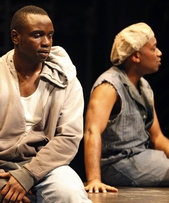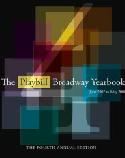SITE GUIDE
SEARCH
REVIEWS
REVIEW ARCHIVES
ADVERTISING AT CURTAINUP
FEATURES
NEWS
Etcetera and
Short Term Listings
LISTINGS
Broadway
Off-Broadway
NYC Restaurants
BOOKS and CDs
OTHER PLACES
Berkshires
London
California
New Jersey
DC
Connecticut
Philadelphia
Elsewhere
QUOTES
TKTS
PLAYWRIGHTS' ALBUMS
LETTERS TO EDITOR
FILM
LINKS
MISCELLANEOUS
Free Updates
Masthead
A CurtainUp Review
The Brother Sister Plays
Part 1: Red and Brown Water
Part 2: The Brothers Size and Marcus or the Secret of Sweet
Part 1: Red and Brown Water
Part 2: The Brothers Size and Marcus or the Secret of Sweet
By Elyse Sommer
|
Come down peace Come down night Cover over Oya girl Maker her world alright — The Men in Red and Brown Water chanting over the young black woman at its center, whose story has moved from buoyant hope to operatic self-destructiveness. I wanna know you still my brother somewhere. . . Any where in the world. You still my brother. . . — Ogun Size I in The Brothers Size Wonder where that come from, calling somebody sweet?—Marcus in Marcus: Or the Secret of Sweet They passed it down to us! Black MoPhobia.—Shaunta Iyun |

Brian Tyree Henry & Marc Damon Johnson in The Brothers Size
(Photo: Joan Marcus) |
All three off these plays bear the hallmarks of McCraney's unique blend of lyrical West African story telling and modern African-American venacular that can be in your face one minute and strikingly poetic the next. The plays l are also permeated with music and movement.
Though McCraney's stories require no elaborate staging, his style affords directors ample opportunity to create powerful stage images and for the actors to shine in multiple roles — which Tina Landau and Robert O'Hara and the acting ensemble indeed do. Under the umbrella title of The Brother/Sister Plays, the trilogy has been divided into two parts, which can be seen on separate evenings or at one of the weekend marathons. The first and longest, In the Red and Brown Water, gets its own evening as Part 1. The Brothers Size and Marcus: Or the Secret of Sweet are combined for Part 2. While each part can stand on its own, this is indeed a triptych that moves forward chronologically and with actors in the first play reappearing as older versions of themselves or as other characters in the second part.
You'll obviously get more of a full life perspective of the characters who populate McCraney's San Pere housing project with its distinctly bucolic African village flavor, if you see both parts:
In the Red and Brown Waters focuses on Oya ((Kianné Muschett), a young girl who misses an opportunity to be a college track star to stay close to her ailing mother (Heather Alicia Simms), then falls into two doomed relationships with the loving but dull Ogun Size (Marc Damon Johnson) and the sexy but unfaithful Shango (Sterling K. Brown). Her inability to conceive a child and Shango's betrayal lead to a gasp-inducing, unnecessarily sef-destructive operatic finale.
The Brothers Size explores Ogun's relationship with his brother Oshoosi (Brian Tyree Henry) who's already been in prison once. The hard-working older brother's efforts to keep his brother out of trouble are sabotaged by Oshoosi's seductive prison buddy Elegba (Andre Holland), who was a trouble-prone teenager in the first play.
The final play, moves things forward with André Holland now playing Marcus, the son Elegba fathered as a teenager in the first play. Though it starts with Shango's funeral and its water images strongly suggests the advent of Katrina, this is basically Marcus's coming out and coming of age story.
Seeing the complete trilogy will also give you a chance to see two different directing styles that connect seamlessly thanks to the the staging, the splendid ensemble acting and the playwright's unifying stylistic elements. Most notable in the latter category are the frequent dream sequences, the melding of poetry and street talk and the device of having the actors speak the stage directions before playing them out. The spoken stage cues not only underline and bold face the characters feelings and actions but fit in with the story telling mode. On the other hand, this device tends to make the audience too aware of seeing a play to be really swept up in the story and, used as extensively as it is, does get a bit tiresome.
As long as I'm quibbling about the intriguing but over used spoken stage directions. . . the non-specific staging and the characters' African names tend to obscure the fact that their stories play out in an American housing project and not a country village in distant Africa. When a reference to the project is actually made it doesn't seem to fit in with what we're seeing and hearing. This is especially true in Tina Laundau's highly stylized staging of In the Red and Brown Water. O'Hara's more naturalistic direction, though also relying on generic props (a table that doubles as a bed and a car) does add a large garage door and some very realistic rain.
Even though the play Ms. Landau directs is wonderfully atmospheric and has an abundance of stunning images, I suppose if you had to choose to see just one part, I'd opt for the second because it features The Brothers Size which is the jewel in this trilogy's crown. Of all the characters, it's Ogun and Oshoosi Size who are the most memorable. As the Public's artistic director Oskar Eustis states in his program notes, they join a parade of brothers who have made dramatic history: Jamie and Edmund of Long Day's Journey, Biff and Happy in Death of a Salesman, Booth and Lincoln of Top Dog/Underdog, Austin and Lee of True West.
The ensemble acting is, as already indicated, outstanding throughout. The actors adeptly slip into and individualize multiple roles — for example André Holland segues from a sweets hungry, nervy youngster to a mysterious and dangerous adult with criminal record, and finally a son looking to his dead father for self understanding. Kianné Muschett is endearing both as the initially buoyant and ultimately tragic Oya of part one and as a high school girl who has yet to realize that the boy she has a crush on is gay. The actor who most consistently makes the audience laugh is Kimberly Hébert Gregory, especially as the first play's Aunt Elegna, a woman of a certain age who's not the least bit uncertain about her enthusiasm for a handsome young man.
No review of this ambitious work would be complete without a shoutout for the design team — especially set designer James Schuette's magician-like way with actualizing locations evoked by dreams and real events and doing so with minimal props. His scenic design is greatly enriched by Peter Kaczorowski's lighting wizardry. Schuette and Kaczorowski also backed Tina Landau's direction of McCraney's Wig Out! which had a run at the Vineyard Theater review) and, like The Brothers Size and In the Red and Brown Water, has already had London productions.
Ultimately The Brother/Sister Plays are all about love, loss and familial ties. The actors' humming, sighing, drumming and singing brings out the Yuroban flavor and rhythm of the stories, but the real music in Terrel Alvin McCraney's play comes from the poetic yet super real language his characters speak.
|
The Brother/Sister Plays Part 1 & Part 2 Playwright: Tarell Alvin McCraney Part 1: Red and Brown Water directed by Tina Landau Cast: Sterling K. Brown (Shang); Kimberly Hébert Gregory (Aunt Elegua) Brian Tyree Henry (The Egungun), André Holland (Elegba), Marc Damon Johnson (Ogun), Sean Allen Krill (O Li Roon / Man From State), Nikiya Mathis (Shun), Kianné Muschett (Oya), Heather Alicia Simms (Mama Moja /Nia/The Woman Who Reminds You). From 10/30/09 Running Time: 2 hours with one intermission Part 2: The Brothers Size and Marcus: Or the Secret of Sweet directed by Robert O'Hara Cast (The Brothers Size): Brian Tyree Henry (Oshoosi Size), André Holland (Elegba), Marc Damon Johnson (Ogun Size) Cast (Marcus): Sterling K. Brown (Shua); Kimberly Hébert Gregory (Shun/Aunt Elegua), Brian Tyree Henry (Terrell/ Oshoosi Size), Andre Holland (Marcus), Marc Damon Johnson (Ogun Size), Sean Allen Krill (O Li Roon), Nikiya Mathis (Shaunta Lyun), Kianné Muschett (Osha), Heather Alicia Simms (Oba). Public Theater 420 Lafayette Street From 10/21/09 Running Time: 2 hours and 45 minutes with one intermission Both parts opening 11/17/09; closing 12/20/09 Scenic design: James Schuette Costume design: Karen Perry Lighting design: Peter Kaczorowski Sound design: Lindsay Jones Music supervision and Additional Vocal arrangements: Zane Mark Stage Manager: Barbara Reo Reviewed by Elyse Sommer at November 15th marathon performance |
|
REVIEW FEEDBACK Highlight one of the responses below and click "copy" or"CTRL+C"
Paste the highlighted text into the subject line (CTRL+ V): Feel free to add detailed comments in the body of the email. . .also the names and emails of any friends to whom you'd like us to forward a copy of this review. You can also contact us at Curtainup at Facebook or Curtainup at Twitter |
|
Subscribe to our FREE email updates with a note from editor Elyse Sommer about additions to the website -- with main page hot links to the latest features posted at our numerous locations. To subscribe,
E-mail: esommer@curtainup.comesommer@curtainup.com
put SUBSCRIBE CURTAINUP EMAIL UPDATE in the subject line and your full name and email address in the body of the message -- if you can spare a minute, tell us how you came to CurtainUp and from what part of the country. |






